The Bagpipe Society
Traditional Croatian Bagpipes
Introduction

Croatia (Hrvatska) is a small country, but with very rich and diverse traditions. Each region in Croatia has specific costumes, dances, songs and musical instruments, often completely different from all the others. There are several reasons for this.
The first is the age of the Croatian people.The Croats occupied the area of today’s Croatia in the 7th century at the invitation of the Roman emperor Heraclius, in order to defend the Roman Empire from the Avars. Croats came from what was known as White Croatia (areas of present-day Poland, the Czech Republic,SlovakiaandUkraine).ThislargeareaofEuropewasinhabitedby Croats together with other Slavic tribes from the 2nd to the 7th century. There are still remnants of the old Croatian tradition in these areas (for example the city of Krakow was founded by Croats, the areas of western Ukraine are still called White Croatia (Bijela Hrvatska), in many of these areas there are still versions of the name Hrvat-Croat in various variants, etc.). The international name for our state and nation is Croatia (Croat), however, our real, original name is Hrvatska (Hrvat).
According to the language, Croats belong to the Slavic peoples, but according to some theories, the origin of the Croats dates back to Persian times, from the area of Iran and Persia. They are mentioned in the time of Emperor Darius and are believed to have originated in the ancient Persian province of Harahvati.
The second is the tradition of the peoples who lived in the area of today’s Croatia before the arrival of the Croats (Celts, Illyrians, etc.). The Croats assimilated these peoples and parts of their tradition certainly survived. The traditional ornamentation of the Croats is in some parts very similar to that of the Celts.
The third reason for the richness and diversity of Croatian tradition is the position of today’s Croatia, which has always been at the crossroads of cultures, trade routes and various influences throughout history. Mediterranean, Balkans, Eastern Europe, Western Europe, Roman Empire, Byzantium, Frankish Empire, Avars, Tatars, Venetians, Turkish conquests, Napoleon, World War I, World War II, settlements and displacements of peoples throughout history…. all this has been mixed for centuries in the areas of today’s Croatia and has left its mark on traditions.
Today’s tradition of the Croatian people (songs, dances, costumes, music and instruments) is a mixture of ancient, indigenous traditions those people who were settled in the area before the before the arrival of Croats (Celts, Illyrians, etc.) and the influence of historical events in these areas. Of course, a lot has remained obscured in history and it is difficult to understand what and how it really happened, but it is important to mention that it would be understood how Croatia, as a relatively small country, has such a rich and diverse tradition.
The origin and development of traditional bagpipes
The earliest bagpipes were simple, primitive instruments consisting of an animal bag or animal bladder, a tube-mouthpiece (usually a piece of reed or hollow bone), and a single chanter with reed. The chanter quickly became double (two pipes), with the same number of holes on both sides. The goal of adding a second pipe was to amplify the sound of the instruments. Over time, the number of finger holes on one side decreased, resulting in two voices. Further development proceeded in several directions. By adding a third or fourth pipe in the chanter or by adding a drone. Various combinations of the number of pipes in the chanter, the arrangement of the finger holes, the number of drones and types of reeds, and the development of technology and the use of more modern materials over time have developed several hundred types and subtypes of bagpipes. It is interesting that even today, in various areas of distribution of musical instruments with bags, you can find the most primitive and modern forms of these musical instruments. The development of musical instruments with bags, in a way, continues even today.
It is very important to understand the difference between different types of bagpipes across Europe. It is not so much the appearance that matters as the number and type of reeds in the chanter. The basic division is into bagpipes with a double-reed (mostly Western European bagpipes) and with a single-reed (mainly Central and Eastern European bagpipes). Within this division there are many more subspecies depending on the number of reeds in the chanter and the arrangement of the finger holes.
Croatian bagpipes

Croatia is extremely rich in traditional musical instruments with bags, and the oldest types of these instruments and newer types have been preserved to this day. We have different names for different types of our bagpipes. Depending on the type of bagpipe we call them: MIH, DIPLE, DUDE, GAJDE. They are all types of Croatian bagpipes, but there are very important differences between them.
Mih or diple
First and the oldest one are the MIH or DIPLE (two different names for the same type of instrument). They are over several thousand years old, and this is a biggest family of old Croatian bagpipes. Common to all types of Mih or Diple are: goat or sheep skin, double chanter with two single reeds, blowpipe, decorative parts.
The chanter of Mih and Diple is always double and according to the number and arrangement of the finger holes on the left and right side of the chanter, we distinguish the following types:
- 6-6 – Mih from Herzegovina
- 6-4 – Mih from the Peljesac peninsula
- 6-3 – Mih from the Korcula island
- 6-2 – Mih from Dalmatia
- 5-3 – Istrian Mih and Piva
- 5-1 – Mih from some islands (Pag, Rab etc.)
There were various other combinations (6-5, 6-1, 6-0, 5-2, 5-0…etc.) but they disappeared over time.
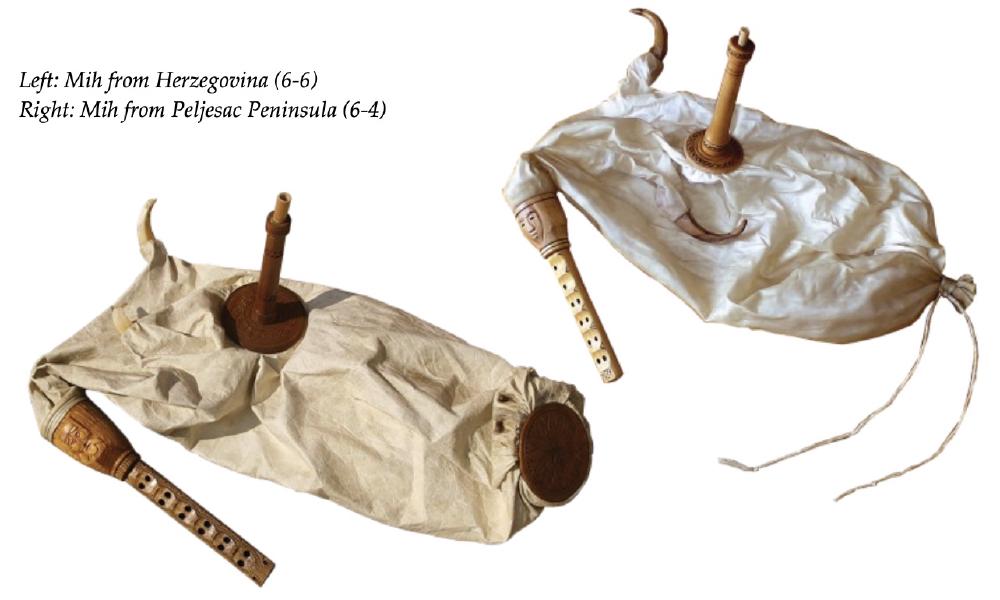
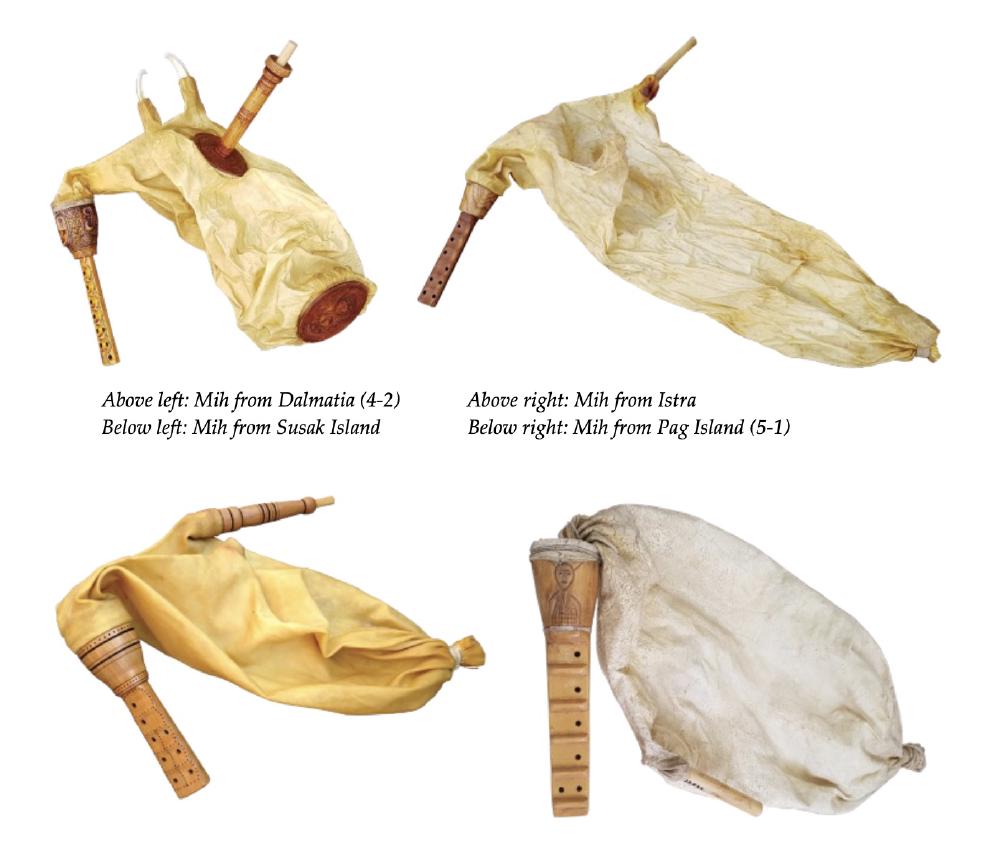
It is important to note that each of these variants of Mihovi and Diple are played completely differently, the fingering, melodies, ornamentation and playing technique are different. Mihovi and Diple are untempered instruments and mostly improvisations are played. Each player had his own, specific melodies that he played and a special playing technique.
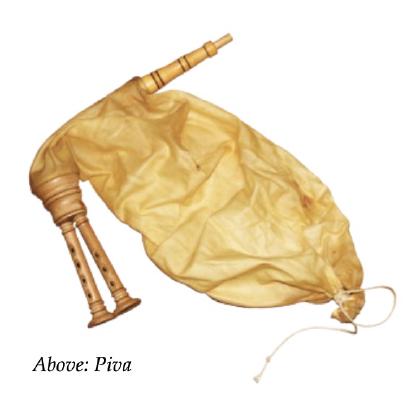
The specificity of the oldest types of Mihovi (Herzegovinian and Dalmatian Mih) is the chanter stock in the shape of a human head, a way of making and decorating that dates back to pre-Christian times and reflects old beliefs and rituals.
Mihovi and Diple are dance instruments, very rarely people sung with them. They were most often played by shepherds while tending herds in the mountains and it is believed that the sound of them would drive the wolves away.
Dude
There are two types of DUDE bagpipes in Croatia, four-voiced and five- voiced. Dude are very old instruments and according to some researchers from the 19th and early 20th century, Dude are one of the earliest, traditional Croatian instruments. It is assumed that the Croats brought some variants of Dude bagpipes with them when settling in the area of today’s Croatia in the 7th century.

It is interesting that Dude are still made in the ancient way of inserting special reed pipes into a wooden casing, which is just one of the indicators of the very great age of these instruments.
Four voiced Dude are tempered instruments, most often in approximately F, F#, or G key. They have three single-reeds in the chanter (three pipes in chanter), and one in drone.
For Dude of G key, the tones that can be played are as follows:
- melodic pipe of chanter - G, A, H, C, D, E
- rhythm pipe of chanter - G and lower quarter D
- third (octave) pipe of chanter - octave G or in rare cases tone F
- drone - deep basic tone of duda F.
Five voiced Dude are tempered instruments, most often in approximately F, F#, or G key. It is a very rare and specific type of bagpipe. They have four single-reeds in the chanter (four pipes in chanter), and one in drone.
The arrangement of tones on the G-key five voiced Dude is as follows:
- melodic pipe of chanter - A, H, C, D, E
- rhythm pipe of chanter- basic tone of Dude G
- third pipe of chanter - upper octave G
- fourth pipe of chanter - lower quarter D
- drone - deep basic tone of Dude G
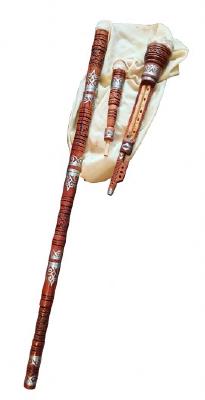
When all the finger holes on the five voice Dude are closed, the chanter is completely closed and no tone sounds. By opening one or more finger holes at the same time, we get a real wealth of harmony and sound. It can sound up to five tones at a time. Player has complete control over all tones in the chanter. That is not possible with bagpipes and four voiced Dude.
That is why five voiced Dude can be considered the culmination of the development of Croatian traditional bagpipes.
Not a single folk celebration could pass without the dudaš (player of Dude bagpipes) playing. It is written that during his visit to the city of Bjelovar in 1888, the Austro-Hungarian Emperor Francis Joseph I was delighted with the playing of Dude bagpipes and the dance of young couples in traditional costumes.
It is written that girls used to persuade or pay a dudaš (player) to play for them on Saturday nights. He would start playing at one end of the village, the girls would sing and dance, and when they reached the middle of the village, up to a hundred dancers would gather around the dudaš in a circle.
Gajde
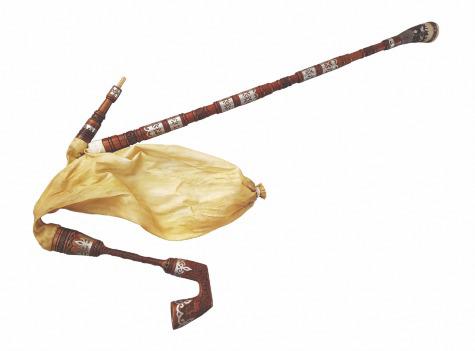
GAJDE are a three voiced instrument and consists of the following basic parts: a bag, a double chanter with two single-reeds, horn, drone and blowpipe. The skin is most often tanned goat skin. All other parts are made of wood, often very nicely decorated with tin, carved or burned ornaments. Gajde originated from the development of more primitive forms of musical instruments such as Mihovi and Diple. It is assumed that the current form of bagpipes originated somewhere in the period from the 11th to the 13th century somewhere in the area of Pannonia. The oldest preserved specimen of Croatian bagpipes is in the Ethnographic Museum in Zagreb and dates from 1751. The problem with finding older specimens is that musical instruments are most often buried with the deceased who played them, so it is very difficult to find older specimens.
Gajde are tempered, playing up to six tones of the major scale on one side of the chanter while the rhythm is played on the other. The drone gives a deep, basic tone throughout the gig. They are most often made in the keys of E and D.
Gajde made in E key have the following tonal sequence:
- melodic chanter - E, F#, G#, A, H, C#
- rhythm chanter - the basic tone of the bagpipe E (when the hole is open) and the lower quarter of the basic tone H (when the hole is closed, in which case the sound comes out through the horn)
- drone - deep basic bagpipe tone - E
Gajde are used for dance and also accompanied by singing. The bagpiper was once an important person, apart from the fact that no celebration or custom could pass without him, bagpipers were often valued so much that they would even judge in disputes and quarrels of the villagers.
Gajde are a solo instrument, but today we play bagpipes with various other traditional and modern instruments. Many Mih, Gajde and Dude players were also appreciated by their people.
Conclusion
These are just the most basic facts about Croatian traditional bagpipes and there is much more that could be written about each instrument. It is important to mention that many of the musical instruments mentioned almost disappeared in the second half of the twentieth century. The Gajde were played by only a few old musicians, the Dude disappeared completely (they were played only by Croats in Hungary) and could only be found in museums.
I will be a little immodest and I must mention that many of these instruments have been restored and brought back to life thanks to my playing, making and research work which I am very glad because it would be a great pity if such a valuable and specific national treasure disappears forever. Reconstructing some instruments was quite difficult, not so much in the making as in the way it used to be played. Luckily, we have some old, original audio recordings from the last century that have been invaluable to me.
Today, many folklore societies in Croatia use the bagpipes in their repertoire and they are increasingly used in modern music.
Stjepan Večković – player, researcher and maker of traditional Croation instruments, he performs with the professional folk dance ensemble, as well as writes and paints. http://www.gajde.com/en/
- Data Processing Notice (GDPR)
-
@BagpipeSociety on X (formally known as Twitter)
-
TheBagpipeSociety on Instagram
-
 BagpipeSociety on Facebook
BagpipeSociety on Facebook
Something wrong or missing from this page? Let us know!
